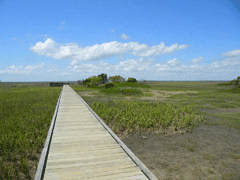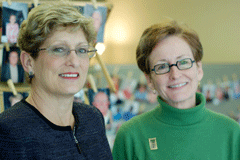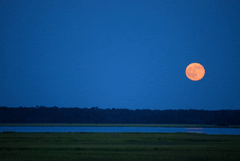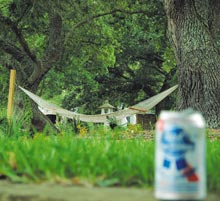The Beaufort Three Century Project begins its third act as we count down to the 2011 Tricentennial Celebration. Interview and Photos by Mark Shaffer
 Happy birthday, Beaufort. January 17th is 299 and counting, which means of course the big 3-0-0 is just a year away. This is going to catch a lot of people by surprise – others, not so much. Since January 2008 the understaffed, budget-challenged Beaufort Three-Century Project (B3C) has been uniquely focused on the city’s tricentennial celebration. The B3C has fostered remarkable efforts to raise public awareness of this landmark in our common history through “a three-year process of exploration, studies, and special events that honor the past to better chart the future…” This piece of the project’s mission statement calls to mind the words of poet and philosopher George Santayana: "Those who cannot remember the past are condemned to repeat it." This concept runs to the very core of what the B3C has accomplished in the first two thirds of its mission, including a daunting digital archive project and a lecture series that generated the sort of ticket sales of which Broadway producers dream. As the B3C enters its final phase, Mark Shaffer talked to Project Coordinator Deborah Johnson and Steering Committee Member Connie Hipp about where it’s been, where it’s going and how to be a part of it.
Happy birthday, Beaufort. January 17th is 299 and counting, which means of course the big 3-0-0 is just a year away. This is going to catch a lot of people by surprise – others, not so much. Since January 2008 the understaffed, budget-challenged Beaufort Three-Century Project (B3C) has been uniquely focused on the city’s tricentennial celebration. The B3C has fostered remarkable efforts to raise public awareness of this landmark in our common history through “a three-year process of exploration, studies, and special events that honor the past to better chart the future…” This piece of the project’s mission statement calls to mind the words of poet and philosopher George Santayana: "Those who cannot remember the past are condemned to repeat it." This concept runs to the very core of what the B3C has accomplished in the first two thirds of its mission, including a daunting digital archive project and a lecture series that generated the sort of ticket sales of which Broadway producers dream. As the B3C enters its final phase, Mark Shaffer talked to Project Coordinator Deborah Johnson and Steering Committee Member Connie Hipp about where it’s been, where it’s going and how to be a part of it.

Mark Shaffer: This is a pretty exclusive club, after all how often does a town turn 300?
Connie Hipp: True, but sometimes the normal town people get so involved in everything else going on that they need a group like B3C to remind them, because we can put our hearts into it. We can juggle all the balls. I would like to see the city of Beaufort really kick it off over the next year and really get involved with it.
MS: How do you provide the heart for something like this?
CH: We care.
Deborah Johnson: And getting people involved – that’s where the heart comes from. Doing these 300 interviews, for example. I mean you interview people all the time, so you know how you get a feeling for a person. We’ve done 35 or 40 by now and we’ll do 300. Every single one of those interviews has made me laugh, made me cry, made me feel something I hadn’t felt before. And I think that when people tell their own stories, that’s where the heart is.
MS: You’re two years into a three-year project, entering the final countdown, so to speak. What are some of the best things from those first two years?
DJ: Most of the projects are on going. The events themselves were big projects – the Tricentennial Lecture Series last year was probably the most visible.
MS: A huge success.
DJ: Big success. Turned away 300 people at the door the first night.
CH: Including me.
(laughter)
MS: How did that feel?
CH: I don’t know. My husband said “you’re on the committee, can’t we go anyway?”
MS: Well, it proves you’re not playing favorites when that happens.
DJ: We also had a county councilman from Hilton Head who didn’t get in and a very high profile individual in town who also did not get in. Actually I had one person out of all of that complain about not getting in. Most people were just bowled over. How could this be? How could this many people care about history on a Friday night in February?
MS: Who knew it was such a draw?
CH: And it was cold that night. I was thrilled to see [such a turnout], to see so many coming out to hear it. But we had such an awesome group talking. I was just thrilled that it was so popular. I’ve already bought my tickets [for the upcoming lectures].
(laughter)
 DJ: Oh, good!
DJ: Oh, good!
MS: This says a great deal about the interest in the project. I mean a history lecture on a cold Friday night in February is a tough sell.
DJ: Four Friday nights. After the first one, the whole rest of the series was sold. So each Friday night close to 500 people packed into that auditorium. We had a special grant for teachers to come and we thought we’d have 20 or 25 show up. We had 70 teachers from the public schools attend. One of them came late because she had a commitment at school and I told her I didn’t think there was anyway to find a seat for her, and she said “oh, I’ll sit on the steps.” She wasn’t upset about not having a seat and that’s the kind of interest we had. It was amazing.
We all went out afterwards – all of us who worked on it – we were kind of amazed that we’d survived the first night. And there was a buzz in town. People were down at Breakwater saying “Did you get in?” “Yes, did you get in?”
MS: Shockingly enough, I was downtown that evening and there definitely was a buzz going around. Hopefully that word of mouth will impact the upcoming series.
DJ: We hope it will sell out as well. They’re exactly the same lectures. We’re repeating them because so many people didn’t get to attend last year, and so Larry and John and Steve* were very gracious about doing it again. I think after it was over last year they were amazed. They we’re kind of like rock stars.
(laughter)
MS: This is always fun and rare for historians. They don’t get that very much.
DJ: It is an awful lot of work for them. Think about trying to relate more than 300 years of history and doing it well. And they were amazing. We were very pleased that they want to do it again.
CH: With out a doubt the best thing that’s happened [to B3C] has been Deborah.
(laughter)
I’m just going to say it outright. It is the truth. She has been awesome. She’s been great about guiding us and encouraging ideas and creativity, bringing things and ideas from other places that help us. Sometimes when you’re on a committee like this you can really love the idea, but if it’s not your strong point you don’t know how to make it happen. And I’ve been most impressed with Deborah and what she does to help us to make it happen and keep things going.
MS: I imagine it would be a rocky trail without a knowledgeable guide. You have to know where to go to try and get the money and the support. A lot of this has to do with [Deborah’s] experience in writing grants.
DJ: We have been very fortunate to get good grants. We’re a three-year project, under a charitable fund that we set up early on through the Community Foundation of the Lowcountry. We didn’t want to start another non-profit and compete with everybody else in town. And we knew that we would be going away in three years. So there are a lot of structural pieces to creating a non-profit that we decided against. And the Community Foundation was great about working with us on a charitable fund and being accountable for donations, gifts and grants so that if somebody donates money they make sure we dot our “I’s” and cross our “T’s.” Connie actually works as our treasurer, too.
MS: You’ve been fortunate to get some key grants in tough times.
DJ: The Humanities Council this year gave us a major grant, which was exciting and wonderful. They’re supporting the entire event series for this year. And we received a grant from the [South Carolina] Forestry Commission, which was kind of interesting.
MS: I saw that and wondered what it might be – and it’s not just the State Forestry Commission, its something called The Urban and Community Forestry Grant Assistance Program funded by the U.S. Forest Service. That’s a whole lot of hoo-ha. What does it mean to B3C?
CH: I think this is going to be very interesting.
DJ: It is. This grant came through a program that usually helps fund cities to do their tree inventories, train staff to be arborists, help people understand the value of a canopy and why it’s important to plant trees and keep them healthy. One of the pieces is also education.
[In the beginning] the Steering Committee put out a list of topics we wanted to cover in some way during the course of the three years, and we [made it known] that anybody can work on a project, anybody can bring a project idea. So, Michael Murphy who has Preservation Tree Care and who is a Master Arborist (a very rare distinction) came to us and said “wouldn’t it be fun if we did a project on documenting the oldest trees in Beaufort?”
MS: That’s a great idea.
DJ: He explained that the species was going to be the Live Oak. People see these huge old trees and think they’re a thousand years old, but if you look at pictures from the Civil War there are almost no trees in downtown Beaufort. That’s the first photographic history we have and there are very few trees. So what we’re going to do is try to find out if any of these trees were here 300 years ago or what the ages of some of these trees are. It’s tough on a live tree because you have to bore it. But there’s a new way of thinking that if you do a fairly tight assessment of the age of one tree then you can project the age of the trees around it.
 There’s an expert, Dr. Henri Grissino-Mayer – a full professor at the University of Tennessee – who’s the nation’s leading authority on tree dating. So, Michael suggested we get in touch with him and see if he’d be interested in coming to Beaufort. Grissino-Mayer already had some tree samples from the Charles Pinckeney Historic Site. [Meanwhile] Michael is planning to document the trees. So, he put something in the newspaper and his staff was inundated with calls the next morning. People were calling in to say they had the oldest trees in their yards. So, he spent the last six or eight months going around documenting trees, finding them, measuring them, photographing them.
There’s an expert, Dr. Henri Grissino-Mayer – a full professor at the University of Tennessee – who’s the nation’s leading authority on tree dating. So, Michael suggested we get in touch with him and see if he’d be interested in coming to Beaufort. Grissino-Mayer already had some tree samples from the Charles Pinckeney Historic Site. [Meanwhile] Michael is planning to document the trees. So, he put something in the newspaper and his staff was inundated with calls the next morning. People were calling in to say they had the oldest trees in their yards. So, he spent the last six or eight months going around documenting trees, finding them, measuring them, photographing them.
He emailed Grissino-Mayer and asked if he’d be interested in coming to Beaufort for this. In the meantime I was going to Tennessee to visit family. I told Michael that I would be an hour from Knoxville and that if [Grissino-Mayer] wanted to get together, I’d go by and talk to him about the B3C project – do that whole cheerleading thing. So, Grissino-Mayer emailed Michael to say “I’m already interested in B3C, but tell Deborah to come by anyway.” It so happened that Michael was Michael was cutting down a dead live oak – a big one – and he said “since you’re going would you mind taking some samples in your car?” (laughter)
It was two weeks after I’d bought my new car and it’s pretty small. So, I went over to Michael’s shop and his guys actually measured my car to figure out which of the samples would fit. They got two big old tree samples in there, and I drove to Knoxville to deliver them, met Grissino-Mayer and his grad students.
MS: And the grant soon followed.
DJ: We got the grant by doing a public education piece. We proposed this symposium and the Forestry Commission thought it was great and funded our project.
The symposium will be Michael presenting his research and Dr. Henri Grissino-Mayer talking about tree ring dating using the samples we took up there. A fellow from Bartlett Tree Experts is coming to be on the panel – they do scientific research behind tree preservation. The Forestry Commission is sending someone. Laura Lee Rose from Clemson University is coming, and in the afternoon we’re going to do tree tours. We think it’s going to be a great program.
MS: It’s a great story and it also indicates that once things are said and done, there will be a lasting legacy from many of these smaller projects within the B3C.
CH: I think it’s just been wonderful. I’m going to help with some of the [interview] transcribing later on and I’ve already [learned so much] just by being part of the Steering Committee. I’ve been here since I was six years old. I’ve known some of these people and heard some of these things, but to hear the extra pieces to the stories – it’s not just Larry and the others talking about what went on in the 1600’s, but about what’s gone on in the last 50, 75 years. Those things need to be captured, too and a lot of what happened last week.
MS: It’s important to realize that it’s not just about what happened 300 years ago or a decade ago, but about what’s still happening – the history in the making.
CH: Everybody’s been so excited about catching all the pieces of it.

MS: B3C also got a pretty substantial check from the Humanities Council [of South Carolina]. They literally maxed out on the grant.
DJ: It’s not a whole lot [of money]. It’s only eight thousand dollars –
MS: But it’s all they can give in this category.
DJ: It is all they can give, and it is their major grant and there are only a few of them given in the state. They’ve given us a lot of good exposure, too. If you look on their website (www.schumanities.org) we’re listed on their calendar and were highlighted all through December. Last year they gave us a very substantial operating grant. We probably couldn’t have functioned without their support.
CH: It’s sometimes easy to get money for projects. But as any organization knows, it’s almost always harder to get money for the normal operations that come with that. B3C has been the recipient of a lot of generosity, but it’s still difficult.
MS: Have you talked to other people in other cities who’ve done these things, compared notes, discussed what worked and what didn’t?
DJ: Well, when we first started we researched what other cities had done, how they had celebrated mainly – not doing what we’re doing so much, but how they had actually celebrated. A lot of people took a real tourist approach to it, others took more of a party approach. Some took a fairly similar approach to ours, but I think ours is pretty unique in that we started this project three years out as a community documentation process. We’re creating a digital archive that can be passed on and protected without having to give boxes and boxes of stuff to the library or [Historic Beaufort Foundation] or whomever.
MS: So who does become custodian of all this?
DJ: We don’t know yet.
CH: That’s still being discussed.
MS: So Connie, in the end when this is all over and done, what’s the lasting impact on the community?
CH: I think we’ve gotten some folks excited about learning about the history, excited about our community in a different way. One of the questions we keep asking people is “what do you want [Beaufort] to look like in a hundred years?” And we’ve actually got them interested in thinking about where we’ve come from and where we’re going. I think that vision forward is good.
(At this point Connie departs for a meeting)
DJ: When we first started talking about the concept of this thing, it was like, so what? So, you do three years of documenting the history and everybody has a good time and what then?
MS: It’s done, we had a big party, it’s over and now we’re left with the hangover.
DJ: Exactly. So, the B3C Project was structured early on – from the very beginning, in fact – for the first two years to focus heavily on documenting the history, getting the community involved in its history. The third year would focus on looking ahead and help people use what they had learned about the past to think about the future – really just having a conversation about the values of the community. Not so much a comprehensive plan or what government does – but things that people care about – and then give this [information] to the people who are the government, who are the deciders.
MS: How would you characterize B3C two thirds of the way in?
DJ: I think it’s a lot like your grandmother’s quilt – it’s about putting all those pieces together. Some people have very rich and learned knowledge about pieces, but they don’t see it in the context of the whole picture. What’s interesting about this project is that it puts [the pieces] in the context of something bigger, it is the whole town, it is the whole place and it makes each piece important. My grandmother made quilts and there would be one piece of fabric in there that I just loved and I’d ask “what is this?” and she’d say “this was your grandfather’s shirt” or “this was an old coverlet” – or whatever it was. I think that’s what we’ve done, put those pieces together, although I don’t think everybody in town will go away knowing every piece.
MS: But there will be a greater appreciation for the quilt.
DJ: Right.
MS: So how will it all end? On January 17th, 2011 what’s going to happen?
DJ: Actually, that’s an interesting piece because we don’t know. There’s another element here that we haven’t talked about: the City of Beaufort’s Tricentennial Commission. B3C started on January 17th, 2008 and will end on that day in 2011. We were not sanctioned by the city or by anyone else. We made a real effort not to be a group representing other groups. We were clearly just citizens concerned with the history and the tricentennial. We talked to the city – at the time Billy [Keyserling] wasn’t mayor** so we didn’t have any official sanctioning, and we thought who are we to claim the tricentennial as the organizers? So, we claimed the three years leading up to it as something we were going to work on and engage as many people as possible and work with as many other organizations who had interest in it. Over the last year the conversation has turned to what are we going to do for the tricentennial? We’ve taken it before City Council to say the city needs to take some ownership in this.
MS: It’s their birthday. You can’t really throw a surprise party for a whole city.
DJ: Especially after you’ve been talking about it for three years. But Billy as mayor brought it up before council, I’ve made several presentations and they’ve had several meetings where they’ve talked about it. As it stands now Councilman Mike McFee will be the city liaison for the Tricentennial Commission. So we don’t really know the answer to that question, yet.
MS: Something like 300 days, 300 parties?
DJ: That sounds like fun.
Contact B3C at 843-489-1711 to find out how you can get involved in the final phase of this landmark, once-in-a-lifetime project. Look for their new website to be up and running in the coming weeks at www.beaufortthreecentury.org. In the meantime, become a fan of the Beaufort Three Century Project’s Facebook page to keep up with projects and events.
Email your tricentennial thoughts to backyardtourist@gmail.com
* Scholars Dr. Lawrence S. Rowland, Dr. Stephen R. Wise and Dr. John M. McCardell, Jr.
** Prior to running for mayor Keyserling was instrumental in organizing the B3C Project.








